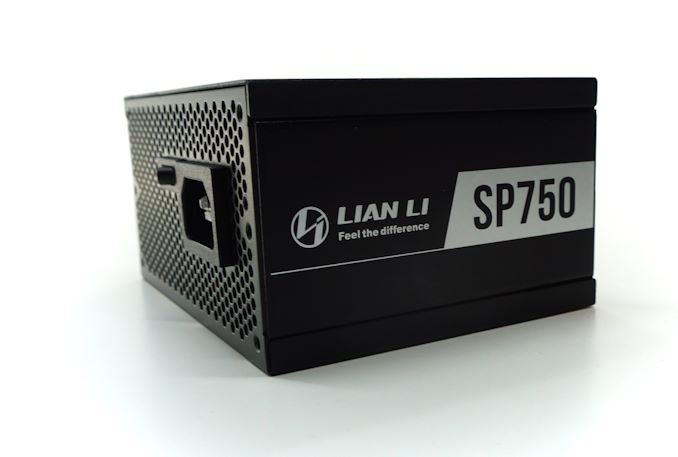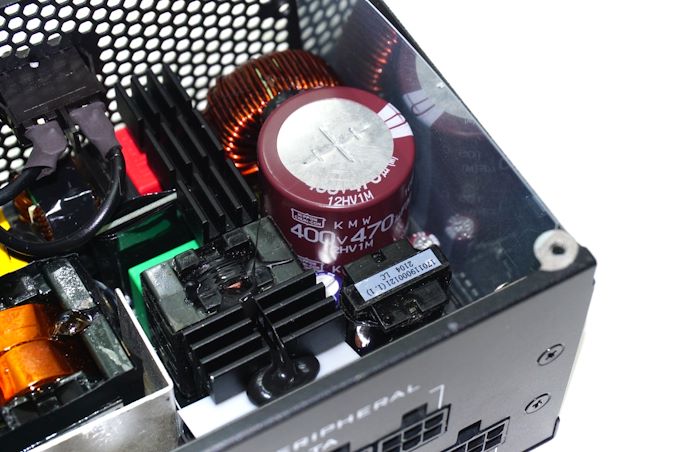The SP750 SFX Gold Review: Lian Li's First SFX Power Supply
by E. Fylladitakis on July 12, 2021 9:00 AM EST- Posted in
- Cases/Cooling/PSUs
- PSUs
- 80Plus Gold
- 750W
- SFF
- Lian Li
- SFX
- SP750
Power Supply Quality
As part of our testing, we also check output parameters are within specifications, as well as voltage ripple and line noise.
| Main Output | ||||||||
| Load (Watts) | 151.04 W | 376.73 W | 562.06 W | 747.72 W | ||||
| Load (Percent) | 20.14% | 50.23% | 74.94% | 99.7% | ||||
| Amperes | Volts | Amperes | Volts | Amperes | Volts | Amperes | Volts | |
| 3.3 V | 1.81 | 3.39 | 4.53 | 3.35 | 6.8 | 3.3 | 9.07 | 3.29 |
| 5 V | 1.81 | 5.1 | 4.53 | 5.04 | 6.8 | 5 | 9.07 | 4.94 |
| 12 V | 11.25 | 12.06 | 28.11 | 12.05 | 42.17 | 11.99 | 56.23 | 11.97 |
Even though they complied with the design power quality guidelines, earlier SFX PSU designs displayed poor power quality figures. However, more recent models, like the SilverStone SX700-LPT and Corsair’s SF450, were greatly improved. Lian Li’s even more powerful SP750 now delivers excellent power quality figures, easily comparable with those of very good ATX units.
| Line | Regulation (20% to 100% load) |
Voltage Ripple (mV) | |||||
| 20% Load | 50% Load | 75% Load | 100% Load | CL1 12V |
CL2 3.3V + 5V |
||
| 3.3V | 3% | 8 | 10 | 12 | 14 | 12 | 18 |
| 5V | 3.15% | 10 | 14 | 16 | 18 | 12 | 18 |
| 12V | 0.75% | 8 | 12 | 18 | 38 | 36 | 12 |
We recorded a maximum voltage ripple of 38 mV on the 12V line under maximum load but much lower figures at lower loads, suggesting that the components were getting thermally stressed. Ripple figures on the 3.3V and 5V lines are lower, barely reaching 18 mV. The voltage regulation of the 12V line is impressive, at just 0.75%, but Lian Li somewhat neglected the 3.3V and 5V lines, the regulation of which is slightly above 3%.
Conclusion
Lian Li took a very strange approach for their first SFX entrance into the power supply market with the development of a premium PSU with a very high-power output. The SP750 is an SFX design meant to power systems that could even be featuring an RTX 3090 – assuming that one can find and afford such a card in the market today. The use for small form factor 750W units powering big cards is small, as few users actually build very powerful yet compact machines, however there are only a few companies that develop and market similar high-output SFX PSUs, meaning that the SP750 does not have as much competition as an ATX PSU would. The use of Helly Technology as the OEM is also a question mark, as we do not often see them used for consumer power supplies.
The quality of the Lian Li SP750 is excellent. Both externally and internally, Lian Li’s designers were very careful with their selection of components and with the manufacturing process. As a result, the SP750 is not just reliable but also very aesthetically pleasing. It is actually strange that Lian Li only covers the SP750 with a 5-year warranty, whereas most other manufacturers offer up to 10 years for products of just as good quality.
When it comes to performance, the Lian Li SP750 does not disappoint. It offers excellent electrical performance, with power quality figures that we expect to see only with top-tier PSU designs. The energy conversion efficiency is exceptional, with the unit easily justifying its 80Plus Gold certification. What is even more impressive is its resilience to high internal temperatures, which hardly affect the unit’s conversion efficiency. The only troubling performance aspect of the SP750 is the cooling fan, which will easily become audible when the PSU is heavily loaded, even with the unit inside a relatively cool system.
Lian Li is targeting a niche market with the release of the SP750 and we believe that the company expects most of their sales to be in conjunction with their own SFX-compliant cases – after all, the SP750 aesthetically is a perfect match for them. Even though the high-performance SFX PSU market is very small, there are also very few competitors right now, meaning that Lian Li only has to worry about a handful of other products and not hundreds of them. The retail price of the SP750 is $140, a very reasonable tag for an SFX PSU with that high a power output.












29 Comments
View All Comments
erinadreno - Monday, July 12, 2021 - link
Is it just me or the PCB layout looks like mirrored from Corsair's SF750?DanNeely - Monday, July 12, 2021 - link
Looking at photos from the review below I don't think so. Off the bat this one has the 2 coils on the side opposite the big capacitor stacked vertically instead of side by side, the heat sinks next ot the big cap are oriented differently; and while it's hard to be sure since al of the images here were taken at more of an angle I think the Lian-Li is more densely packed.https://pcper.com/2019/01/corsair-sf750-sfx-platin...
romrunning - Monday, July 12, 2021 - link
Thanks for the review! I am not surprised Lian Li entered the SFX market first, because not only do they manufacture a number of custom ITX cases (i.e. ready-made customers), but the SFX PSU market itself has fewer competitors. The ATX PSU market has enough already. Hence, it makes perfect sense to enter the SFX side first.The Corsair SF750 mostly dominates the SFX PSU market at the 750W point, so another competitor at that level is desirable. I'll be interested to see if this one made by Helly Technology is just as good, quality/reliability-wise, as the Corsair one.
The fan is hopefully not a bad choice. I would have wanted one chosen more for quiet operation, because I really treasure a quiet system, especially when ITX cases don't have as much internal volume to "deaden" the sound.
u.of.ipod - Monday, July 12, 2021 - link
I think it has less to do with the fan choice and more to do if they set the fan curve aggressive or not, and if they base the fan curve on actual temperature or just general load.romrunning - Monday, July 12, 2021 - link
The review said: "The 92 mm fan started when our load was just over 200 Watts", so it sounds like a more aggressive curve. I don't know if this unit has a specific "ECO-mode" or configurable semi-passive mode. I know on my SF750, I've yet to hear the fan in the PSU kick on past the initial system power-on. Personally, I'm okay with the fan running, as long as it stays quiet (or at least always less than the system/GPU fans). :)Oxford Guy - Tuesday, July 13, 2021 - link
'I think it has less to do with the fan choice and more to do if they set the fan curve aggressive or not'1. Ball bearing fans are noisy. Single-bearing fans are the worst.
The only exception I have seen to this rule is some single-speed dual-bearing low-RPM fans designed for high static pressure, which did seem to be very competitive with competing tech (e.g. 800 RPM model from industrial company whose name I can't recall).
The main reason, as far as I know, for using dual-bearing fans, is for high static pressure situations (i.e. radiators, especially those with airflow high resistance).
2. How aggressive the fan needs to be depends on various factors that can be controlled by the OEM, such as the quality of the electronics (efficiency) and the quality of the airflow/heatsink aspect. This review suggests that one of the sinks isn't very good and gold is not the best PSU electronics can do.
The profile isn't just plucked out of the sky. It has to provide adequate cooling under load.
romrunning - Monday, July 12, 2021 - link
"What is strange here is the presence of three PCI Express connectors, because the SP750 clearly has the power output for two middle-range graphics cards but the lack of a fourth connector deprives users from that choice"ITX boards only have one PCIe x16 slot for a dGPU, so this isn't a problem at all.
Slash3 - Monday, July 12, 2021 - link
There are a number of midsize cases that will hold a Micro ATX or full sized ATX motherboard, but still require an SFX power supply, including their own popular O11 Dynamic Mini.https://lian-li.com/product/o11-dynamic-mini/
meacupla - Monday, July 12, 2021 - link
dGPU is dead anyways, so it doesn't matter.DanNeely - Monday, July 12, 2021 - link
Only for gaming, not compute.